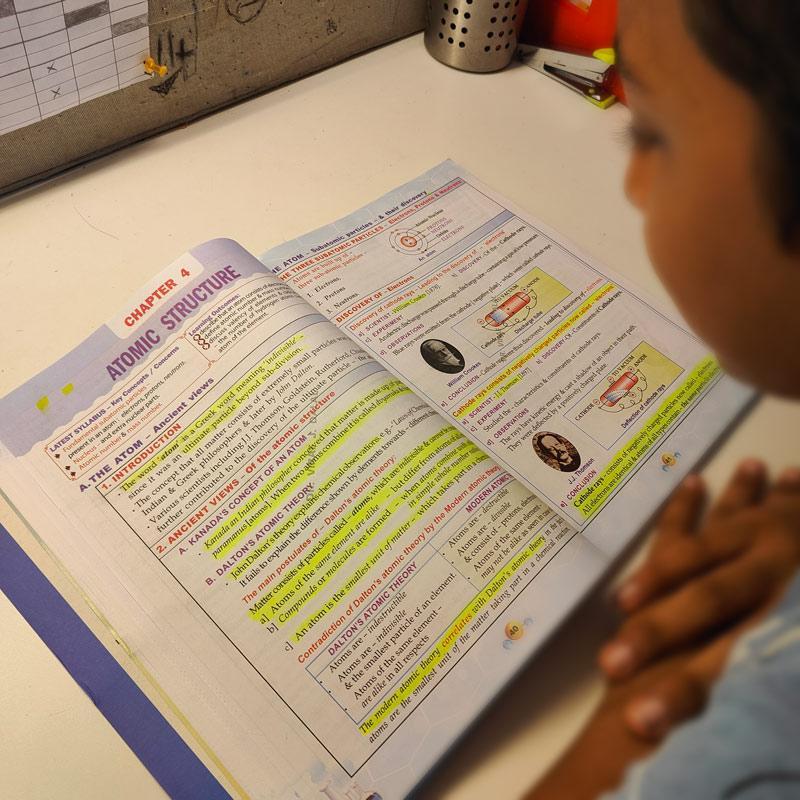
13 May The God In Chemistry – An Atomic Insight
Today my son needed some assistance with his chemistry homework, specifically with the chapter on ‘Atomic Structure’. When I asked him what he was struggling with, he replied, “Everything in it!” I knew I had my work cut out over the weekend. I couldn’t help but think to myself, “Atomic Structure, another weekend lost!”
While remaining calm at the prospect of losing another lazy and leisurely weekend, I decided to fulfill my fatherly responsibilities and proposed to read the chapter with him. As we settled down at his desk, a sense of nostalgia washed over me as I delved back into the world of chemistry, a subject I hadn’t explored in over thirty years.
While reading through the chapter, it became apparent to me that not much has changed in the world of chemistry education over the years. Textbooks have become less aesthetically pleasing, and it made me wonder if teachers have also become less effective at transmitting knowledge, even though the content remains largely the same. This struck me as odd considering the abundance of new resources and educational methods available in recent years. It felt like we were stuck in a time warp, unable to break free from the past and embrace newer, more effective ways of teaching and learning. How and why did our education system end up like this?
Upon reflection, I realised that three major issues plague the field of current school education.
- Firstly, there is a problem with the poor design and presentation of educational materials, which often leaves students feeling disinterested and unmotivated.
- Secondly, there is an emphasis on memorisation and test-taking to obtain good grades, rather than fostering genuine understanding and curiosity.
- Finally, education has become commercialised, with a focus on performances and results which can be talked about, rather than a pursuit of knowledge for its own sake.
These days, educational institutions primarily teach for examinations, and students learn to achieve top marks in those exams. Schools are increasingly driven to acquire more bells and whistles to remain competitive in the industry. This leads to further commercialisation, reflected in rising fees for basic education. The joy, pleasure, and discovery of knowledge have become secondary to the invisible hand of economics and commercialisation, with schools, teachers, students, and parents all participating in the race.
As someone who is passionate about science and education, I knew I had to do something. While I may not be able to change the entire industry or revolutionise the world of education, I could at least try to make a difference in my own small way, however minuscule it may be. So, today, I decided to share an engaging story about ‘Atoms’ with my son. I started from the times when ‘matter’ was the only matter, tracing the evolution of atomic theory over time when ‘atoms’, ‘matter’, and ‘energy’ became interconnected and unified. We discussed the indestructibility of atoms until it was proven that they can be broken down into subatomic particles. We explored electrons, protons, and neutrons, and talked about the scientists who discovered each of these subatomic particles and how they did so. I explained that as time went by, scientists realised that ‘energy’ is just as important as ‘matter’. Eventually, Einstein artistically proved that ‘matter’ and ‘energy’ are different manifestations of a universal whole.
With each anecdotal reference I shared, my son’s fascination with chemistry grew. I could see his interest piquing. We agreed that theories are not universal constants; they change with time as better understanding makes old theories redundant and new ones relevant, until an even better theory comes along, so on and so forth.
From there, we smoothly transitioned to understanding the iconic formula “E=mc^2.” We even calculated how much astounding energy 1 gram of matter holds! It’s 89,875,517,873,682 joules. See the table below to see what this energy is capable of. This realisation sparked more curiosity in my son, and we delved into how “E=mc^2” was utilised in the creation of the atomic bomb. I explained to him how an atomic bomb functions. We touched upon the concept of isotopes, drawing connections to the various isotopes of uranium—some natural, while others artificially created. In a lighthearted moment, I jokingly told my son that we too can be like isotopes, embodying multiple versions of ourselves, and call them ‘avatars’.
Capitalising on my son’s enthusiasm for chemistry, I veered off into a bit of pseudo-science, explaining that as humans we are also composed of ‘matter’ and ‘energy’ derived from the same atoms and subatomic particles. When we are alive, our bodies harmoniously balance the interplay between ‘matter’ and ‘energy’ that makes us who we are. And when we die, the ‘matter’ within us dissociates from the ‘energy’ we possess. A part of our ‘energy’ perhaps becomes one with the vast energy that surrounds us, unseen but felt.
At this point, my son abruptly asked me, “Is there a God?”
I couldn’t help but smile at the profundity of his inquiry. What a question to ask while studying ‘Atomic Structure’! After all, even Einstein had famously posed the same question when delving into the mysteries of quantum mechanics. It seemed we were confronted with a question that has persisted for over a century, perhaps much longer. Amidst the countless unsolved mysteries of the universe, I felt humbled and wondered who am I to complain about thirty-year-old content in school textbooks today!
Embracing my son’s inquiry, for that is what education is all about, I implored him to answer the question himself. He replied that he wasn’t sure. This led to another discussion on the newfound topic “Is there a God?”, leaving us both feeling enriched and enlightened.
And to me, that is a small victory—a glimmer of hope that perhaps, just perhaps, my purpose is to inspire my son to be curious, to question everything, and in doing so, fall in love with the process of discovering our multiple potentials, our many avatars. In the midst of commercialisation and the rigours of performance-driven rat races, we can successfully navigate the challenges of education with inner peace, by unlocking an ‘isotope’ of ourselves—an avatar—emanating pure and inspiring ‘energy’, akin to a godlike feeling, perhaps akin to being a ‘God’.
That’s how, we – my son and I – today found the God in chemistry.
Here are some more specific examples of what 89875517873682 joules of energy can do. These examples provide numerical estimates based on rough averages and assumptions.
- Power a large city: On average, a city of approximately 100,000 households consumes around 1 gigawatt-hour (GWh) of electricity per day. With 89875517873682 joules of energy, you could power this city for approximately 2,471 days, or roughly 6.77 years.
- Propel a spacecraft: The amount of energy required to launch a spacecraft into space varies depending on its mass, destination, and propulsion system. As a reference, the Saturn V rocket used during the Apollo missions had a total energy of about 170 gigajoules (GJ). With 89875517873682 joules, you could power multiple launches or propel a spacecraft over vast distances.
- Trigger a powerful explosion: A ton of TNT releases approximately 4.184 gigajoules (GJ) of energy upon detonation. With 89875517873682 joules, you could produce the energy equivalent of approximately 21,508 tons of TNT.
- Melt substantial amounts of metal: The energy required to melt a specific metal varies depending on its melting point and specific heat capacity. As an example, to melt one ton (1,000 kilograms) of iron, you would need approximately 2.56 gigajoules (GJ) of energy. With 89875517873682 joules, you could melt around 35 million tons of iron.
- Power industrial machinery: Industrial machinery varies widely in power consumption. For instance, a large industrial motor may consume around 1,000 kilowatts (1 megawatt) of power. With 89875517873682 joules, you could power such a motor continuously for approximately 89875.5 hours, or around 10.25 years.
P.S.: Those of you who have contacts in Royal Swedish Academy of Sciences, Sweden, may kindly put a word about our discovery. We are ready to receive Nobel Prize in Chemistry 2023. We thank you in advance and promise to mention about you in our acceptance speech.
If you liked this post, then you may consider reading A Story of Obsolescence, Death, Reuse, Rebirth and Hinduism, Shraddh and a Miracle also



No Comments